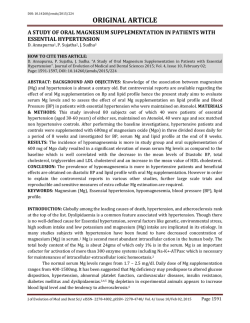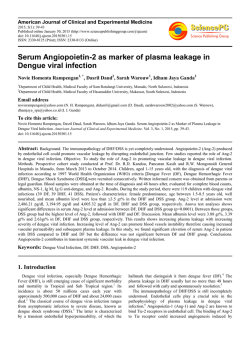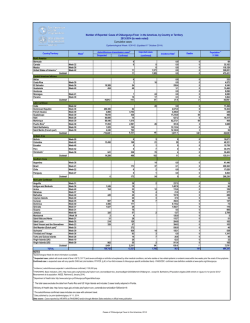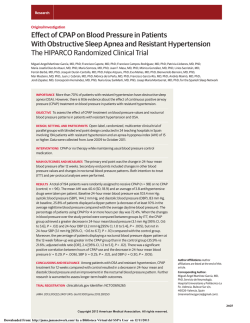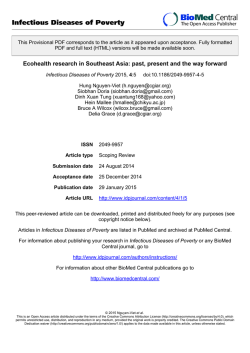
- 1 - Dear friends of clinical journal club: The N - charite
Dear friends of clinical journal club: The N Engl J Med image of the week is an abdominal transverse CT. We observe a stomach filled with dark matter. You are offered gastrointestinal stromal tumor, obstipation, pancreatic phlegmon, subphrenic abscess, and trichobezoar. We discuss all these conditions. How hypertension during pregnancy should be managed is unclear. Thus, hypertensive pregnant women were randomly assigned to less-tight control (target diastolic blood pressure, 100 mm Hg) or tight control (target diastolic blood pressure, 85 mm Hg). The composite primary outcome was pregnancy loss or high-level neonatal care for more than 48 hours during the first 28 postnatal days. The study showed that tight control of hypertension conferred no apparent benefits to the fetus and only a moderate benefit (a lower rate of progression to severe hypertension) for the mother. Angioedema induced by treatment with angiotensin-converting–enzyme (ACE) inhibitors accounts for one third of angioedema cases in the emergency room. Icantibant blocks the bradykinin B2 receptor and could help the condition. Investigators assigned patients who had ACE-inhibitor–induced angioedema of the upper aerodigestive tract to treatment with 30 mg of subcutaneous icatibant or to the current off-label standard therapy consisting of intravenous prednisolone (500 mg) plus clemastine (2 mg). The primary efficacy end point was the median time to complete resolution of edema. Icantibant may have helped. Ruxolitinib, a Janus kinase (JAK) 1 and 2 inhibitor, was shown to have a clinical benefit in patients with polycythemia vera in a phase 2 study. Thus, investigators conducted a phase 3 open-label study to evaluate the efficacy and safety of ruxolitinib versus standard therapy in patients with polycythemia vera who had an inadequate response to or had unacceptable side effects from hydroxyurea. Ruxolitinib was effective in controlling the hematocrit, reducing spleen size, and improving symptoms in patients with polycythemia vera who had an inadequate response to or had unacceptable side effects from hydroxyurea. The next investigators randomly assigned 3066 premenopausal women with breast cancer, stratified according to prior receipt or nonreceipt of chemotherapy, to receive 5 years of tamoxifen, tamoxifen plus ovarian suppression, or exemestane plus ovarian suppression. Exemestane was not convincing in my view. On the basis of the 2014 guidelines for hypertension therapy in the United States, many eligible adults remain untreated. Epidemiologists projected the cost-effectiveness of treating hypertension in U.S. adults according to the 2014 guidelines. If you like crystal ball gazing you will love this paper. The N Engl J Med reviews allergic rhinitis. We learn that combining a nasal antihistamine with an intranasal glucocorticoid could offer additive effects. In cases in which pharmacotherapy is -1- ineffective or not acceptable to the patient, allergen-specific immunotherapy could be used. The case of the week concerns a 49 year-old person with a broad anion gap metabolic acidosis and envelope-like structures in his urine. Lancet investigators randomly assigned 490 adults with rheumatoid arthritis who had pain and dysfunction of the hands and had been on a stable drug regimen for at least 3 months, to either usual care or usual care plus a tailored strengthening and stretching hand exercise program. The exercises seemed to help. Trend data for causes of child death are crucial to inform priorities for improving child survival by and beyond 2015. The next group reports child mortality by cause estimates in 2000–13, and cause-specific mortality scenarios to 2030 and 2035. Despite the importance of ST-segment elevation myocardial infarction (STEMI) in China, no nationally representative studies have characterized the clinical profiles, management, and outcomes of this cardiac event during the past decade. The Chinese STEMI patients resemble STEMI patients elsewhere. Dengue viruses have spread rapidly within countries and across regions in the past few decades, resulting in an increased frequency of epidemics and severe dengue disease, hyperendemicity of multiple dengue virus serotypes in many tropical countries, and autochthonous transmission in Europe and the USA. If you know what autochthonous means, you are better than me. We review the topic. The patient of the week is a 71-year-old man with a 1-week history of lethargy, worsening confusion, and cough. He has eosinophilia, acute cerebral infarcts, and lung lesions. Join me Wednesday at 17.00 in the clinic or elsewhere if you wish. Check out the file pdf at http://www.charite-buch.de/ or at https://www.scienceopen.com/group/discussions/c27ba389-490c-466a-a6e1ec811f0b7d71;jsessionid=b9QoL5ao-HNtipQxJzuzoyPK.slave:so-app2-prd?0 then per YouTube: http://www.youtube.com/channel/UC369gGQevtN3HNJYmzqdBqQ Keywords: Hypertension in pregnancy, angioedema, ACE inhibitors, Hypertension guidelines, icantibant, polycythemia, ethylene glycol, rheumatoid arthritis, dengue, ChurgStrauss vasculitis. -2-
© Copyright 2025

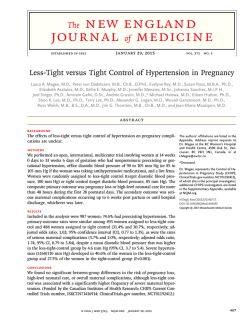
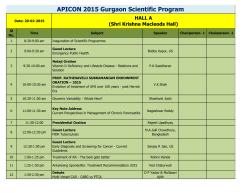
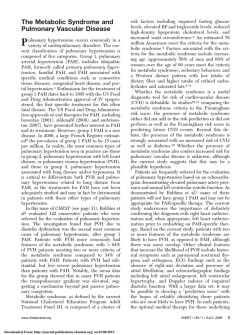
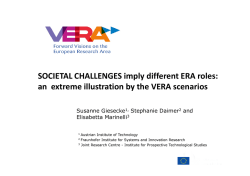
![Download [ PDF ] - journal of evolution of medical and dental sciences](http://s2.esdocs.com/store/data/000475167_1-3fd66abd823a299e32f0bb1f6c6f6a60-250x500.png)


